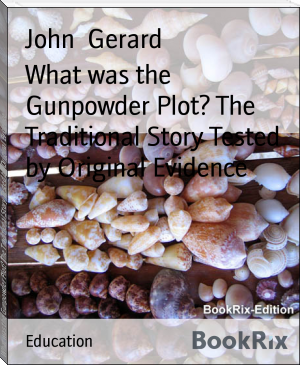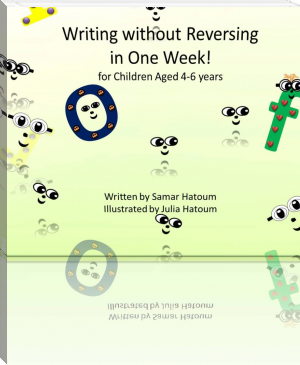What was the Gunpowder Plot? The Traditional Story Tested by Original Evidence by John Gerard (top 10 most read books in the world .TXT) 📕

- Author: John Gerard
Book online «What was the Gunpowder Plot? The Traditional Story Tested by Original Evidence by John Gerard (top 10 most read books in the world .TXT) 📕». Author John Gerard
[154] Faukes, as has been said, makes the work upon the wall terminate at Candlemas. Winter (ut sup.) says that they brought over the powder at Candlemas, that is, after they had been some time engaged upon the wall, and found the need of the assistance of Keyes.
[155] Lord's Journals "A^o 1604(5) 2 Jac.--Memorandum quod hodierno die, septimo die Februarii, A^o Regis ñri Jacobi, viz. Angliae (etc.) 2^{ndo}, & Scotiae 38^o, in quem diem prorogatum fuerat hoc praesens parliamentum, convenere Proceres tam Spirituales quam Temporales, quorum nomina subscribuntur."
Then follow twenty-nine names, including the Archbishop of Canterbury, Lords Ellesmere (Chancellor), Dorset (Treasurer), Nottingham (Admiral), Suffolk (Chamberlain), Northumberland, Cranborne (Cecil), Northampton, etc. It is noted "Lords Montagu, Petre, and Gerard [all three Catholics] were present, though they were none of the Commissioners."
[156] Narrative (Stonyhurst MSS.), fol. 44 b.
[157] This absurd supposition is obviously implied by Faukes (November 17th, 1605), and T. Winter (November 23rd), in the only two accounts furnished by any of the conspirators wherein the episode of the mine is mentioned. In Barlow's Gunpowder Treason (Harleian Miscellany, iii. 123) it is expressly stated that the confederates "came to the knowledge of the vault" only on the occasion now detailed. Tierney says (Dodd's Church History, iv. 45, note): "At this moment an accidental noise ... first acquainted them with the existence of the cellar."
[158] On the 3rd of October following, Thomas Winter was sent to be present at the ceremony of prorogation, and to watch the demeanour of the assembled peers.
[159] Gunpowder Plot, p. 55. This account is based almost entirely on that of Faukes, November 17th, 1605.
[160] In his Italian version of Father Gerard's history, Father Greenway interpolates the following note: "Questi non erano carboni di legno, ma una sorte di pietra negra, la quale come carbone abrugia et fa un fuogo bellissimo et ottimo" (fol. 44 b).
[161] "These Pioneers through Piercies chamber brought Th' exhausted earth, great baskets full of clay; Thereby t' have made a mighty concave vau't, And of the house the ground worke tooke away: But then at last an obstacle they finde, Which to remove proud Piercy casts in 's mind. A thick stone wall their passage then did let; Whereby they cou'd not finish their intent. Then forthwith Piercy did a sellar get, Under that sacred house for yearly rent: Feigning to fill 't with Char coal, Wood, & Beere, From all suspect themselves to cloake & cleere."
JOHN VICARS, Mischeefes Mysterie.
This remarkable poem, published 1617, is a much expanded translation of Pietas Pontificia (in Latin hexameter verse) by Francis Herring, which appeared in 1606.
[162] On this point we are furnished with more than the usual amount of variety as to details. Cecil, writing to the ambassadors (Cornwallis, Edmondes, etc.), says there were "two hodgsheads and some 30 small barrels." The King's Discourse mentions 36 barrels. Barclay (Conspiratio Anglicana) says there were over 9,000 lb. of powder, in 32 barrels, and that one of extra size had been placed under the throne, for treason could not without dread assail Majesty even when unarmed. The indictment of the conspirators named 30 barrels and 4 hogsheads. Sir E. Coke always said 36 barrels. Barlow's Gunpowder Treason makes the extraordinary statement, frequently reproduced, that "to the 20 Barrels of Powder laid in at first, they added in July 20 more, and at last made up the number Thirty-six." Faukes (November 5th) said that of the powder "some was put in hoggesheads, some in Barrels, and some in firkins." Faukes also says that the powder was conveyed to the place in hampers. John Chamberlain, writing to Dudley Carleton, November 7th, 1605, says it was carried in satchels. Barlow (ut sup.) quotes the amount as 9,000 or 10,000 lb.
[163] November 23rd, 1605.
[164] The Gunpowder Plot, by L., 1805. It seems highly probable that the "cellar" was used as a public passage.
[165] Hugh F. Martyndale, A Familiar Analysis of the Calendar of the Church of England (November 5th). London, Effingham Wilson.
[166] Letter to Cornwallis and Edmondes, November 9th, 1605.
[167] H. F. Martyndale, ut sup.
[168] Letter to the Ambassadors, ut sup.
[169] An Advertisement written to a Secretarie, etc. (1592), p. 13.
[170] Sir R. Naunton, Fragmenta Regalia (Harleian Miscellany, ii. 106).
[171] Blount to Parsons (Stonyhurst MSS.), Anglia, vi. 64.
[172] Such letters are found amongst the State Papers.
[173] The amount, it would seem, cannot have been less than this. A barrel of gunpowder, containing four firkins, weighed 400 lb., and had the casks in the cellar all been barrels, in the strict sense of the word, the amount would therefore have exceeded six tons. Some of these casks, we are told, were small, but some were hogsheads. The twenty barrels first laid in are described as "whole barrels." (Faukes, January 20th, 1605-6.)
[174] An interesting illustration of this point is furnished by a strange piece of evidence furnished by W. Andrew, servant to Sir E. Digby. Sir Everard's office was to organize the rising in the Midlands, after the catastrophe, but he apparently forgot to supply himself with powder till the very eve of the appointed day. Andrew averred that on the night of November 4th, his master secretly asked him to procure some powder in the neighbouring town, whereupon he asked, "How much? A pound, or half a pound?" Sir Everard said 200 or 300 lb. Deponent purchased one pound. (Tanner MSS. lxxv. f. 205 b.)
One Matthew Batty mentioned Lord Monteagle as having bought gunpowder. (Ibid. v. 40.)
In the same collection is a copy of some notes by Sir E. Coke (f. 185 b), in which the price of the powder discovered is put down as £200, i.e. some £2,000 of our money.
[175] Gunpowder was measured by the last = 2,400 lb. (Tomline's Law Dictionary.) In 1607 there were delivered out of the store 14 lasts and some cwts. In 1608 the amount in various strong places is entered as: "Dover Castle, 4 lasts; Arcliffe Bullwark, 1 last; Walmer, 1 last, 8 cwt.; Deal Castle, 1 last; Sandown Castle, 2 lasts, etc.; Sandgate, 1 last; Camber, 1 last."
[176] The position and character of the "cellar" admit of no doubt, as appears from the testimony of Smith's Antiquities of Westminster, Brayley and Britton's Ancient Palace of Westminster, and Capon's notes on the same, Vetusta Monumenta, v. They are, however, inconsistent with some circumstances alleged by the government. Thus, Sir Everard Digby's complicity with "the worst part" of the treason, which on several occasions he denied, is held to be established by a confession of Faukes, which cannot now be found among the State Papers, but which is mentioned in Sir E. Coke's speech upon Digby's arraignment, and is printed in Barlow's Gunpowder Treason, p. 68. In Sir E. Coke's version it runs thus: "Fawkes, then present at the bar, had confessed, that some time before that session, the said Fawkes being with Digby at his house in the country, about which time there had fallen much wet, Digby taking Fawkes aside after supper, told him he was much afraid that the powder in the cellar was grown damp, and that some new must be provided, lest that should not take fire."
Seeing, however, that the powder stood above ground, within a most substantial building, and could be reached by the rain only if this should first flood the Chamber of the Peers, it does not seem as if the idea of such a danger should have suggested itself.
Another interesting point in connection with the "cellar" is that the House of Lords having subsequently been removed to the Court of Requests, and afterwards to the Painted Chamber, "Guy Faukes' Cellar" on each occasion accompanied the migration. From Leigh's New Picture of London we find that in 1824-5, when the Court of Requests was in use, and the old cellar had completely disappeared, Guy's Cellar was still shown; while a plate given in Knight's Old England, and elsewhere, represents a vault under the Painted Chamber, not used as the House of Lords till after 1832. Such a cellar seems to have been considered a necessary appurtenance of the House.
[177] Afterwards the Electress Palatine.
[178] Gardiner, Hist. i. 245; Lingard, vii. 59; T. Winter, November 23rd, 1605.
[179] Faukes, November 17th, 1605.
[180] Harry Morgan, Examination (R.O.), November 12th, 1605.
[181] T. Winter, November 23rd and 25th, 1605. As the information about Prince Henry was alleged to have been communicated by Lord Monteagle, the passage has been mutilated in the published version to conceal this circumstance.
[182] Faukes, November 5th, 1605.
[183] Sir E. Digby, Barlow's Gunpowder Treason, App. 249.
[184] Faukes, November 17th, 1605.
[185] Digby, ut sup.
[186] History, i. 239.
[187] There is also an allusion to the same in the confession of Keyes, November 30th, 1605; but this document also is of a highly suspicious character. Of the seven miners, none but these three were taken alive; Catesby, Percy, and the two Wrights being killed in the field. Strangely enough, though Keyes may be cited as a witness on this subject, on which his evidence is of such singular importance, the government, for some purpose of its own, tampered with the confession of Faukes wherein he is mentioned as one of the excavators, substituting Robert Winter's name for his, and placing Keyes amongst those "that wrought not in the myne." See Jardine's remarks on this point, Criminal Trials, ii. 6.
[188] His detailed notes and plans are given in Vetusta Monumenta, vol. v.
[189] Page 4.
[190] See Appendix E, Site of Percy's house.
[191] Tanner MSS. lxxv. § 185, b.
[192] Faukes, November 6th, uses the same expression, "a low room new builded," which seems to imply that this receptacle had been constructed since Percy came into possession of the house.
[193] November 6th, 1605. More will be seen of the important document containing this information.
[194] According to Smith's plan (sup. p. 59) there were four entrances to the cellar, none of which can have been Percy's "new dore."
[195] We are told that Faukes was selected to take charge of the house, and perform other duties which would bring him into notice, because being unknown in London he was not likely to excite remark. In his declaration, November 8th, however, he gives as his reason for going abroad, "lest, being a dangerous man, he should be known and suspected." It is obvious that in the meantime the cellar must either have been left in charge of others better known, and therefore more likely to excite suspicion, or have been left unprotected.
[196] November 17th, 1605.
[197] Thomas Winter, November 23rd, 1605.
[198] F. 66.
[199] This, as we have heard, was Mr. Whynniard, who unfortunately died very suddenly on the morning of November 5th, on hearing of the "discovery," evidence of great importance as to the hiring of the house and "cellar" being thus lost. "As for the keeper of the parliament house," says Goodman, "who let out the lodgings to Percy, it is said that as soon as ever he heard of the news what Percy intended, he instantly fell into a fright and died; so that it could not be certainly known who procured him the house, or by whose means."--Court of King James, i. 107.
CHAPTER V. (THE GOVERNMENT INTELLIGENCE DEPARTMENT.)




Comments (0)